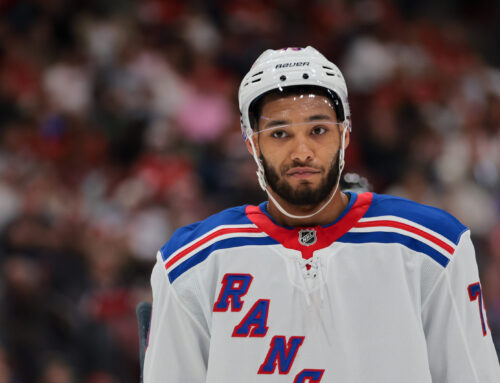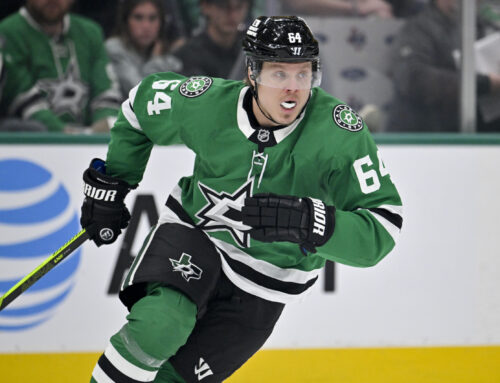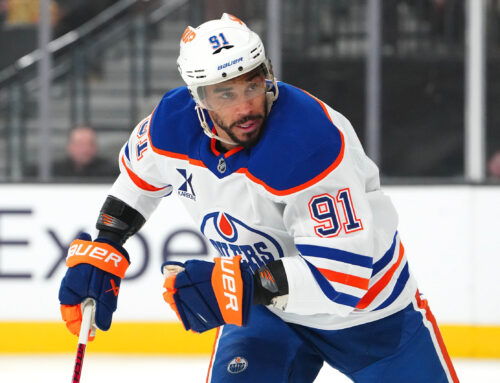Puck luck is one of the hardest things to measure in hockey. There are different ways to try and measure luck, but one of my favourites is by using individual points percentage (IPP).
IPP measures how often a player picked up a point when a goal was scored with him on the ice. If a team scores 100 goals when the player is on the ice, and he gets a point on 60 of them, his IPP is 60 percent. If the next season he had points on 50 of the 100 goals, that a drop of 10 percentage points, or the same as 10 assists.
Just remember that not everyone who sees a drop in IPP will have fewer points. In the previous example, if the player picked up a point on 75 of his team's 150 goals, that reduces his IPP to 50 percent.
According to this article by Travis Yost at TSN.com, an average NHL forward picks up a point on 68 percent of goals scored. For defensemen, that is about 30 percent. That article is a few years old, but the numbers shouldn't have changed significantly, if at all. Elite players will have a higher IPP since the puck is on their stick more often.
Below are 10 players who had a lower IPP this season than normal. Some of them still had great years even with the reduced IPP, but their production would have been much higher had their IPP been in their normal range.
10. Josh Anderson
The 26-year-old Anderson surely had a season to forget for Columbus. Injuries limited him to 26 games, where he had only one goal and four points. His shot rate dropped 0.38 shots per game and his ice time was down a minute over last year. His shooting percentage was a paltry 1.6 percent, much lower than the 11.7 percent he averaged the previous three seasons. Despite still being on the second power-play unit, he didn't have a power-play point. His IPP was 30.8 percent, compared to around a 60 percent average the previous few years. Anderson will be neglected in some drafts for next season, but you would be wise to remember his name as a potential bounce-back candidate.
One of my favorite columns to pen each year is one looking at potential first-time 70-point players. Last year, one of my biggest whiffs was Arvidsson. In 2018-19, he had 34 goals and 48 points in 58 games, a 68-point pace. This year, he had a disappointing season, with 28 points in 57 games, a 40-point pace. While there were numerous reasons behind the decline, a small bit of it could be chalked up to puck luck. His IPP dropped from 64 percent last year to 56 percent this season.
8. P.K. Subban
I've talked about Subban a lot over the past year, on everything from most disappointing players to players who need a fresh start to worst contracts. However, if his drop in IPP is any indication, he could be set for a bounceback. As we mentioned at the start, an average defenseman will pick up a point on about 30 per cent of the team's goals, unless the players handle the puck more or are elite. For much of his career, Subban's IPP ranged from 46 to 52 percent with a couple of outlier seasons. Last year, it dropped to 42.5 percent, and this season further still to 32.7 per cent. It begs the question, is Subban now an average defenseman or is this another outlier season? If you believe it's the former, stay away from him in fantasy hockey. If you believe it's the latter, try to buy low while you can.
For six of his first seven years, Backstrom's IPP was above 72.4 percent, reaching a high of 84.3 percent in 2016-17. It then dropped to an average of 65.6 percent in the two seasons preceding this one. A small drop, but a noticeable one. This season, that IPP dropped to 60.7 percent. Even with the lower IPP, he was still on pace for 73 points. However, that dropping IPP should be a concern in forthcoming seasons.
6. Matt Dumba
One of Dumba's biggest roadblocks to becoming a stud fantasy defenseman has to do with a teammate that is almost 10 years older. With 35-year-old Ryan Suter still producing at a high clip (he had a 57-point pace this year), Suter still gets the reps on the top power-play unit. Although Minny splits their power play almost evenly between the two units, it goes without saying that playing with top players will lead to more points, which is where Suter sits. Dumba's IPP dropped from 45.5 and 47.8 percent the last two seasons to 30.8 percent this year.
5. Nazem Kadri
Maybe it was a move to a new city and a new organization, but Kadri's IPP cratered this season. In his last six seasons in Toronto, his IPP was never lower than 60.9 percent, and three times he reached 70 percent and once he was at 88 percent. In his last season with the Leafs, his IPP was 61.1 per cent. In his first season in Colorado, that dropped to 50 percent. Despite the drop, he still put up his third-highest points-per-game pace of his career simply because the team scored more with him on the ice.
After two seasons that moved Rielly to the upper echelon of fantasy defenseman, the Leafs defenseman was disappointing this season with 27 points in 47 games (a 47-point pace). Shortly after 16 points in his first 17 games, he was taken off the top power-play unit in favor of Tyson Barrie. Rielly also battled injuries as well as puck luck, as his IPP dropped from an average of 51 percent the previous two seasons to 38 percent this year.
3. Joe Pavelski
There are plenty of reasons behind Pavelski's disappointing season. His ice time was down more than two minutes per night from last season with San Jose, he wasn't as proficient on the power play, he took way fewer shots and he had his second-lowest shooting percentage of his last nine campaigns. It didn't help that his IPP also dropped to 50 percent, easily the lowest of the past decade. He normally averages 66 percent. Sixty-two goals were scored with Pavelski on the ice this season. If he had his average IPP, you're talking about a season of 41 points instead of 31, and he would have been on pace for 50 points over 82 games. It still would have been considered a poor season, but not nearly as bad as it was.
2. Brock Boeser
Don't fall into the trap of thinking that Boeser's move off the top line at the end of the season could explain a lower IPP. That would explain a decrease in points or points-per-game, but not IPP. You would have to imagine that he should still be picking up points on the same percentage of the goals scored. For some reason, his IPP has gone from 72.4 per cent in 2017-18 to 63.6 per cent last year to 55.6 per cent this season. That's a significant and worrisome drop.
Here is what was crazy for Bergeron owners this season: Despite a significant decrease in IPP this year, he still had a highly-productive season. His IPP dropped from 69.3 per cent average the previous two seasons to 51.9 per cent this year. That drop was significant. This season, he had 56 points in 61 games. Had he continued with an average IPP, he would have finished with 74 points.





 SEA
SEA NYI
NYI BUF
BUF DAL
DAL
 CBJ
CBJ ANA
ANA STL
STL L.A
L.A NYR
NYR TOR
TOR
